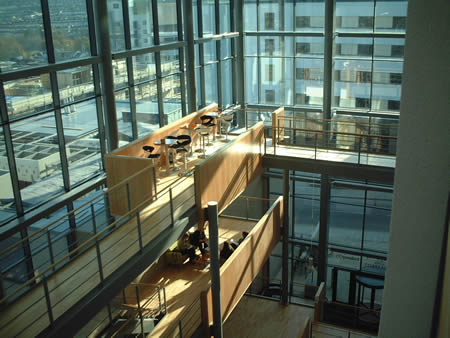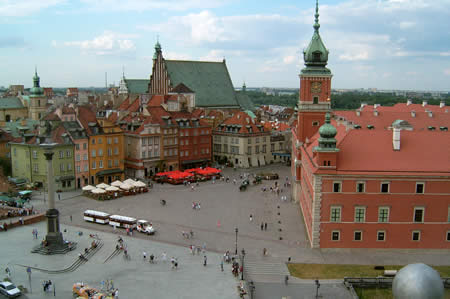Here’s a recording in a mystery language. Do you know or can you guess which language it is and where it’s spoken?
Month: November 2007
Swyddfa newydd
Dydd Gwener yr wythnos hon, symudon ni, yr Adran Busnes Rhyngrwyd, i ein canolfan newydd – symudodd y myfyrwyr a’r athrawon ar ôl gwyliau hanner tymor y mis diwethaf, a symudan yr adrannau eraill yn ystod yr wythnosau nesa. Cyn hynny, roedd y coleg, yr ysgol saesneg fel iaith estron, y lletyau ar gyfer y myfyrwyr, a’r swyddfa gweinyddiaeth mewn mannau gwahanol. Bellach, mae popeth yn yr un man mewn adeilad newydd sbon ger orsaf rheilffordd Brighton yng nghalon y ddinas.
Dyma llun o’r canolfan newydd:

Mae’r canolfan newydd yn teimlo yn fwy eang na’r hen swyddfa, ac mae’r golygfeydd yn wych. Mae e’n fwy golau hefyd.
Oifig nua
Dé hAoine an seachtain seo, d’aistrigh muid, an Roinn Gnó Idirlín, i ár ionad nua – d’aistrigh na mic léinn agus an múinteoirí i ndiaidh lár téarma an mhí seo caite, agus aistreoidh na roinne eile i rith na seachtaine seo caite. Roimhe seo, bhí an coláiste, an scoil Béarla mar teanga eachtracha, na hallaí cónaithe ar son na mic léinn, agus an oifig riaracháin in áiteanna éagsúla. Anois, tá gach rud san áit ceanna i bhfoirgneamh úrnua in aice leis an stáisiún traenach Brighton i lár na cathrach.
New office
On Friday of this week, we, the Internet Business Department, moved to our new centre – the students and teachers moved there after half term last month, and the other departments will move there during the next few weeks. Before now, the college, English language school, student residences and administrative office were all in different places. Now everything is in the same place in a brand new building near Brighton railway station and the centre of town.
Language quiz
Here are recordings of the first verse of a famous Christmas carol in four different languages. I’m sure you’ll be able to recognise the carol, but can you work out which languages they are, and which of them is the odd one out?
30,000 words a day
According to a study undertaken by Infoture, children who at least 30,000 words a day from their parents and other people around are likely to excel academically as they grow up.
The study found that children who heard at least 33 million words (30,000 a day) from birth the age of 3 tend to have higher IQs at the age of 10 than those who hear fewer words. The study also found that television viewing tends to significantly decrease the amount of conversation in a home, which negatively effects children’s language and academic development.
Infoture has developed a system called LENA (Language ENvironment Analysis system) which provides parents with information about their children’s language environment such as the number of words spoken by parents and children.
Word of the day – twmpath
Today’s word, twmpath (/tʊmpaθ/), is the Welsh word for a tump, hump, hummock, tussock or mound. It is also refers to a type of barn dance, which is sort of the Welsh equivalent of an Irish ceili.
The English word tump (a mound or hillock) might come from twmpath, though the dictionaries I’ve checked give it’s origin as unknown.
According to this site, there was a tradition in Wales for people gather on the twmpath chwarae (lit. “tump for playing”) or village green in the evenings to dance and play various sports, usually starting on May Day. A fiddler or harpist would sit and play on a mound in the middle of the green and people would dance around them.
Other uses of this word include twmpath gwadd, mole hill, and twmpath cyflymder or speed bump, a traffic calming measure sometimes called a ‘sleeping policeman’ in English. What are such things called in your language?
Deconstructing languages
In a recent post on his blog, Tim Ferriss explains how he deconstructs languages in order to get an idea of their structure, grammar, sound system and writing system. This gives him an idea how long it will take and how difficult it will be to learn each language and helps him to decide whether or not to do so.
His method is the find native speakers, ask them to translate a number of sentences into their language, writing them in their native writing system, if one exists, and in transliteration. The translations of the sentences give him an overview of verb conjugates, word order, whether or not noun cases and/or auxiliary verbs are used. If possible, he also asks the native speakers to give examples of words for each consonant and vowel.
Some of the sentences he uses include:
The apple is red.
It is John’s apple.
I give John the apple.
We give him the apple.
He gives it to John.
She gives it to him.
I must give it to him.
I want to give it to her.
He suggests that before you take the plunge into learning a language, it’s worth your while finding out just what you’re letting yourself in for. He compares it to a return on investment – with some languages you will get a much better return, i.e. you will learn them more rapidly, than with others.
I also found an interview with Tim Ferris in which he discusses some of his techniques for learning languages.
Where in the world?
Bwriadau da
Bron pob penwythnos, bydda i’n meddwl bod rhaid i mi ddysgu yr eirfa a’r gramadeg fy ieithoedd mewn ffordd mwy systematig, neu ymarfer y chwiban yn amlach, neu ddysgu mwy am seineg, a bydda i’n dechrau ei wneud yr wythnos nesa. Mae llawer o fwriadau da ‘da fi, efallai gormond ohonyn nhw, ond dw i’n arfer heb wneud dim llawer neu ddim byd amdanyn nhw.
Beagnach gach deireadh seachtaine, bím ag smaoineamh gur cheart dom an foclóir agus an ghramadach mo theangacha a fhoghlaim níos córasacha, nó an fheadóg a chleachtadh níos minice, nó níos mó foghraíocht a fhoghlaim, agus tosóidh mé na rudaí seo a dhéanamh an seachtain seo chugainn. Bíonn go leor rudaí, b’fhéidir barraíocht acu, ar m’intinn agam, ach de gnách, ní déanaim mórán nó faic fúthu.
Mystery con-script
Word of the day – typography
Typography is:
1. the art or process of printing from type;
2. the art or process of setting and arranging type for printing;
3. the arrangement, style, or general appearance of printed matter
(from yourdictionary).
It comes via French and Latin from the Greek τύπος (typos), to strike + γραφία (graphia), to write.
I chose this word today because I found an interesting blog about typhography called I Love Typography. As well as discussing typography, the author also gives advice on creating your own fonts, something that quite a few people ask me about. There are also some slightly less-than-serious posts, such as this one about Typoholism, “A disorder characterized by the excessive consumption of and dependence on type…”.
I think I ‘suffer’ from typoholism, and a related condition for which I can’t think of a word at the moment. Can you think of a word for my love of languages and writing systems? Perhaps ‘panglotophilia’.
